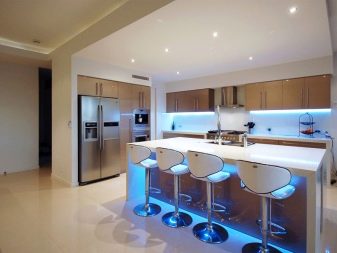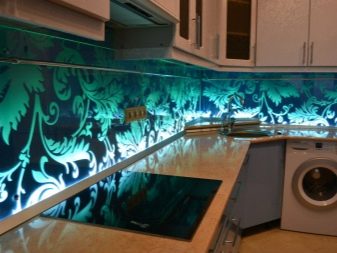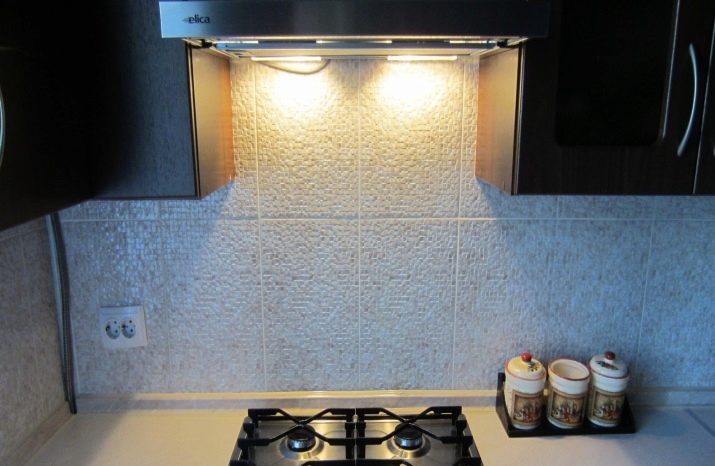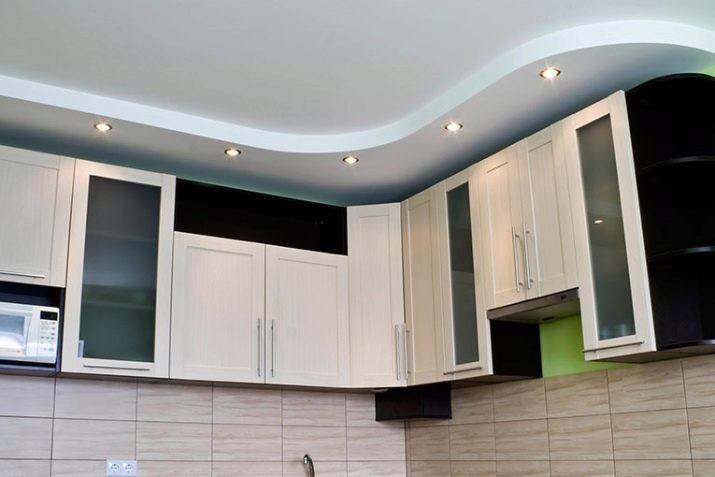Organization of lighting of the kitchen working area is an integral stage in the design of the kitchen interior. It allows you to provide coziness and comfort of the room, gives it great functionality and practicality.



What is the backlight for?
Illumination of the working area can be installed in selected places or around the perimeter of the kitchen apron. It saves space from a pile of linear lamps, providing an adequate level of lighting above the countertop. Such light is auxiliary, it is necessary to facilitate cooking.
The luminaires located in the working area are not so much elements of aesthetic appeal and zoning of the space as a matter of elementary safety. They minimize the likelihood of burns and bruises, which may be due to poor lighting of the work area.

Illumination has a beneficial effect on vision and reduces the likelihood of depression associated with the presence of dim light resembling a semi-basement atmosphere.
This modern approach to compensating for the insufficient lighting of the working area is necessary. It is in the working area that more attention is paid to the hostess: this is the most functional area, which should be better illuminated than others. The backlight should increase the functionality of the working space, correctly directing the light flux.



Primary requirements
Regardless of the design and desire of the homeowners, the lighting of the working area is subject to a number of certain requirements. For example, she should:
- increase the comfort of the household preparing food;
- exclude a sharp glow in the eyes;
- to illuminate all corners of the working surface of countertops and stoves;
- provide for installation in accordance with technical standards and regulations;
- comply with established fire safety rules;
- be selected taking into account the calculated lighting in order to exclude excessive light sharpness;
- differ in acceptable cost;
- correspond to the approximate design of other lighting sources;
- successfully fit into the interior, taking into account the specific area of the working area;
- designed with the simultaneous acquisition of furniture elements.



In addition, the selected type of illumination of the working area in the kitchen must meet the standards of practicality, be easy to care for and as convenient as possible in terms of access to the switches. Depending on the preferences of the buyer, the product may have a different look.
Types of lighting
The illumination of the working area of the kitchen set depends on its variety. For example, in the absence of top modules in furniture, fixtures can be suspended or built into the ceiling. But if the furniture has upper cabinets, you can equip it with other types of lighting. In general, it can be represented by products of various types: spotlights, fluorescent lamps, as well as LED strip.






The choice of one type or another may be due to the design of the planned interior or the preferences of the owners of the house. Products can be simple or touch (with built-in motion sensors), which significantly increases their convenience and allows you to save light when it is not needed. As for chandeliers, today they are not so popular for isolating the working area of the kitchen.


The reason for this is the closure of the incident light from the ceiling by the cook.
In this regard, spotlights are more convenient, although in most cases they have a directional light flux. Fluorescent lamps are characterized by a uniform type of lighting space. However, the most convenient form of illumination, nevertheless, is an LED strip. Depending on the type, it can have a uniform or variable light.



This type of lighting is mounted on the upper cabinets of the kitchen over the apron using brackets, glue or double-sided tape. Such lamps are economical, durable and resistant to moisture. They are also used if it is necessary to illuminate the working area without cabinets, but with cantilevered shelves or other decorative ledges. At the same time, the backlight is almost hidden from view, but allows you to make the lighting of the working area nontrivial.


Accommodation
The type of lamp for lighting the working area of the kitchen can be different, which is reflected in the place and method of its placement. All backlight options can be divided into different categories: with directional light, without adjusting the angle of inclination, swivel and built-in kitchen apron (illuminated skinned). Variants with directional light are called spots, they are mounted in two ways: directly on the wall mounted cabinets or immediately below them.



These lighting devices can be both an auxiliary type of illumination, and the main one.
Analogs of a rotary type provide for the adjustment of the angle of inclination of the light flux. This is very important for cases when you need to adjust the direction of light to illuminate a particular corner of the cooking zone, excluding sharp light in the eye. They are mounted not only on the wall, but also on the ceiling, they are able to become the main lighting devices. Suspended models are used less often, since not every owner of the house likes to put up with the upper light, which closes his head.

Interior lighting is as good as creating the depth of the kitchen apron. It cannot be said unequivocally that it fully compensates for the lack of illumination of the working area.Rather, this type of placement focuses on the aesthetic component than on the practicality and illumination of work surfaces. However, the light is scattered, not beating in the eyes, which is quite good.


The placement of the backlight can be multi-zone, moisture-proof, distributed, hidden and LED-profile. In the working area, it can be located in an extractor hood (in fact, an integrated type), above some hinged drawers, in the lower tier of furniture and even under countertops that are made of glass or a translucent composite material. In addition to the apron, the backlight can be located inside the wall-mounted cabinets-showcases or open shelves.






Profiles can be overhead, angled and built-in, they are mounted on the wall. As for the tape, it can be installed on the hood, the glass surfaces of the wall cabinets, and with a sufficient height of the walls - and above the cabinets. If the working area is equipped with a peninsula, the backlight is placed on the ceiling. In addition, you can highlight the cabinet above the sink.


Each type of accommodation has its own nuances.
- Ceiling lights do not give light to the entire working area, which is why it can have dark areas.
- Placing inside the apron gives a soft, subdued light, but is not always sufficient.
- If the spotlight is not set correctly, the light will hit the eyes.
- The highlight of the sink should be special. This may require the use of light beams or tape.
- Not all types of light sources can withstand high temperatures and humidity.
- Some products have plastic components, which is why they are completely impractical and short-lived.


Choice of fixtures
Choosing your own version of fixtures, you can not ignore the type of kitchen set. Today, some manufacturers make furniture with special boxes for fixtures of a particular type. If the furniture is just that, there is no reason to be smart with lighting fixtures.

In addition, it is necessary to consider masking the wires.
Wiring can be hidden or open, located in plastic cable channels. Some fixtures buy with the installation of wiring a wall, others buy when the main repair is already completed. Someone does hide the wires behind the shelves. Of all types of lighting, the best option is considered to be over hanging cabinets.
Such lighting not only makes up for the lack of illumination of the working area, but also optically raises the ceiling, making the walls higher. In this case, preference is often given to LED strip. It not only turns on quickly and does not heat up, but is characterized by silent operation and a variety of design. Besides, in the process, it does not release toxins into the air that are harmful to the health of households.

Choosing the type of luminaire for the working area, it is necessary to proceed from the destination. If this is a decorative illumination, it is selected under the shelves with glass doors and often turns on manually. The functional type of backlight turns on automatically. These luminaires can be operated by batteries or by supplying electricity through a step-down transformer.
Looking at the type of lighting of the working space of the kitchen, you can choose not only the contact, but also the non-contact type of devices that can be switched on when moving structural elements. If furniture has not been bought yet, you can start with it: often large sellers have the right assortment of lighting for specific furniture.

As for the basement lighting of the working area, it does not carry a practical load. This is a decorative lighting that gives the kitchen a special atmosphere.
Of no small importance when choosing is the color temperature of the purchased light sources. Often it is she who creates a special atmosphere in the kitchen and is selected depending on the style of the interior of a particular room, taking into account the location of the windows. For example, colored light sources (type of RGB lamps) are appropriate in the modern style.Cold are used in modern style.


However, when buying, it is worth considering the fact that for someone the cold color of the light flux is unacceptable. In addition, cold lighting is inappropriate in a kitchen with windows facing north. This room is visually uncomfortable, it seems dark. At the same time, too warm light in the southern kitchen is also undesirable, such a room seems stuffy.
When buying auxiliary lighting devices for the kitchen working area, it is worth considering the available area of a particular room. It is undesirable to complicate the interior with a heap of lamps. In addition, you need to immediately determine the temperature of the light, because it should be as close as possible to natural daylight. Otherwise, the eyes of the household will get tired when they are in the kitchen.



If the backlight devices are purchased for self-installation, it is preferable to take on-load type options, the installation of which any home owner will cope with. It is important to take into account the level of necessary illumination, since excess light will hit the eyes and consume excess electricity. Do not buy lights in a hurry, an unreasonable approach can result in unjustified expenses and a bad result.

You need to take lighting devices in a trusted store with a good reputation. This will eliminate the likelihood of buying low quality products that may not meet safety standards.
Good examples in the interior
We offer some examples. successful location of the working area lighting.
- Illumination of the working area of the kitchen through spotlights.

- Lighting skinned with built-in LED strip.

- Fastening lighting devices to the lower facade of the wall cabinets of the kitchen set.

- Installation of diode strips under the hinged drawers of the kitchen.

- Mounting diodes on the front edge of the upper cabinets of the headset.

- Mounting the lamp with a strip that protects the eyes from directional radiation.

- The use of standard fixtures with a modern design.

- Design approach to lighting the working area of the kitchen using plasterboard ceiling construction.

- Lighting of individual elements of the kitchen.

- The option of lighting the stove under the hood, washing and worktops.

On how to organize the lighting of the working area in the kitchen with your own hands, see the video below.










